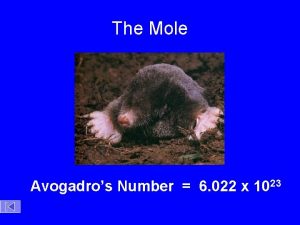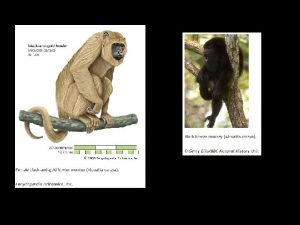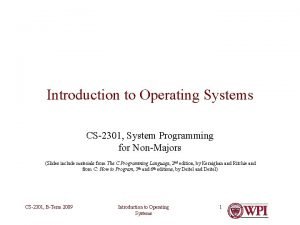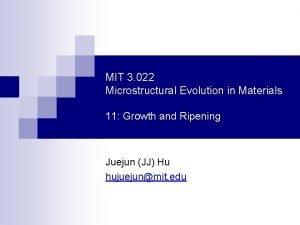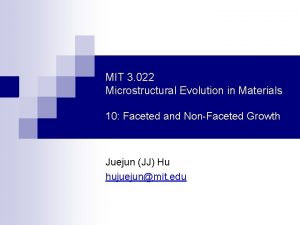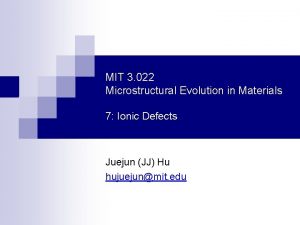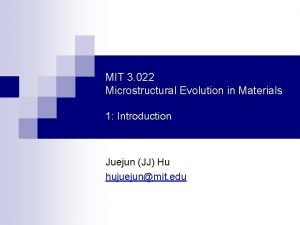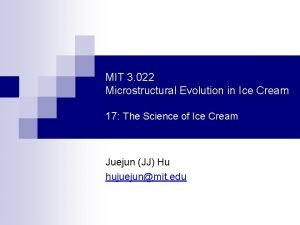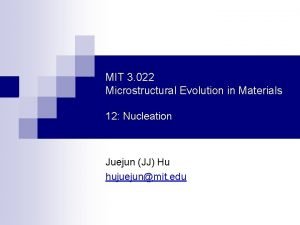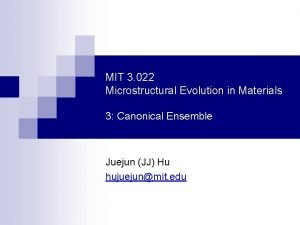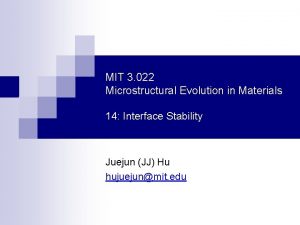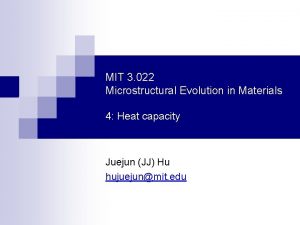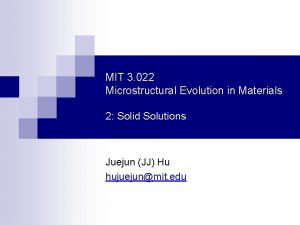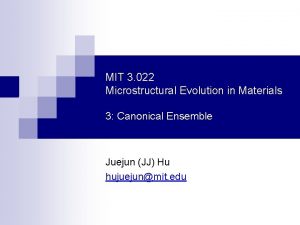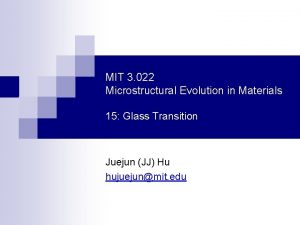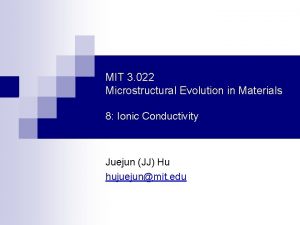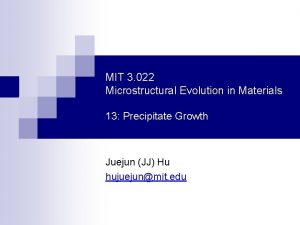MIT 3 022 Microstructural Evolution in Materials 14
















- Slides: 16

MIT 3. 022 Microstructural Evolution in Materials 14: Interface Stability Juejun (JJ) Hu hujuejun@mit. edu

Dendritic growth © Aqueous Technologies

Condition for dendritic growth: interface instability Solid A B x Liquid Stable interface: planar growth Solid A B x Liquid Unstable interface: dendritic growth

Example 1: Bridgman-Stockbarger crystal growth melt

Example 1: Bridgman-Stockbarger crystal growth Solid Liquid T Heat flux Tm Singlecomponent system x

Example 1: Bridgman-Stockbarger crystal growth n n Heat flux continuity at solid-liquid interface Supercooling in liquid Solid Liquid T Heat flux Tm Planar interface: heat removal via the solid side Singlecomponent system x

Example 2: Solidification in a supercooled liquid n n Heat flux continuity at solid-liquid interface Supercooling in liquid Solid Supercooled liquid T Heat flux Tm Heat extraction is more efficient at dendrites Singlecomponent system x

Dendrite branching and crystallography <100> Directionally solidified Co-Sm-Cu alloy Image credit: University of Cambridge CC BY-NC-SA 2. 0 UK Image credit: Alexey Kljatov CC BY-SA 4. 0

“At sub-zero temperature, moisture from the surrounding atmosphere condenses almost immediately. The dendritic form of the crystallization is a natural fractal pattern. ” – Francis Chee / Science Photo Library

Example 3: constitutional supercooling CL Ca Solid a Liquid L L T 0 CB CL b a C 0 Ca x x=0 A C 0 B

Example 3: constitutional supercooling n Solid a CB Steady state solution Liquid L RDt CL C 0 Ca x x=0 Growth rate is determined by diffusion of solute away from the interface

Example 3: constitutional supercooling n Liquidus temperature Ca CL L n Supercooling in liquid T 0 a A b C 0 B Interface stability condition

Example 3: constitutional supercooling Solid a Liquid L CB Critical T (x) TL CL TL (C 0) C 0 TL (CL) Ca x x=0 Liquid L Supercooling zone DT (x) > 0 x x=0

Summary n Interface stability criterion: supercooling decreases away from the solid-liquid interface ¨ Single-component system: ¨ Binary or multi-component system: n In single component systems, latent heat removal from the solid phase side usually indicates stable interface n Phase transition occurring at condition far away from equilibrium (large supercooling) is often accompanied by dendritic growth n Impurities can lead to constitutional supercooling and dendrite growth (even in nominally ‘single-component’ alloys)

List of symbols n DT – supercooling, defined as the difference between the liquidus temperature and the phase transition temperature n Tm – melting point or liquidus temperature n T – temperature n x – coordinate along the x-axis n k. S / k. L – thermal conductivity of solid / liquid phase n R – precipitate growth rate measured by the velocity of the solid-liquid interface n DHm – enthalpy of fusion per unit volume n CB – concentration of component B n C 0 – concentration of B in the starting liquid phase

List of symbols n T 0 – temperature at which the solidification takes place n Ca / CL – equilibrium concentration of component B in the a / liquid phase at T 0 n D – diffusion coefficient of B in the liquid phase n TL – liquidus temperature of the A-B binary alloy, which is a function of the alloy composition CB
 Culpabilidade
Culpabilidade Dizabilitate locomotorie
Dizabilitate locomotorie 6 022 x 10^23
6 022 x 10^23 Household materials useful and harmful
Household materials useful and harmful Man made map
Man made map Adapting and adopting materials
Adapting and adopting materials Cant stop the feeling trolls go noodle
Cant stop the feeling trolls go noodle Direct materials budget with multiple materials
Direct materials budget with multiple materials Evolution of visual basic
Evolution of visual basic Paa doc evolution
Paa doc evolution Evolution of living organisms
Evolution of living organisms Human evolution
Human evolution Describe the evolution of entrepreneurship
Describe the evolution of entrepreneurship Evolution mutation nation answers
Evolution mutation nation answers Cs2301
Cs2301 Evolution
Evolution Let's think in english
Let's think in english


